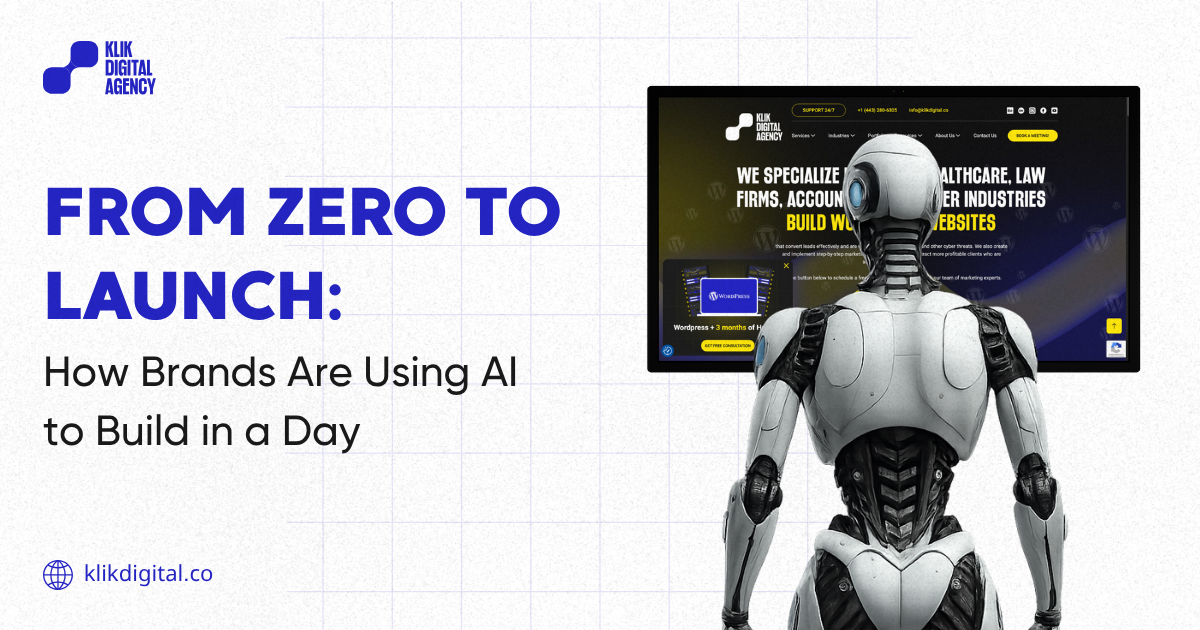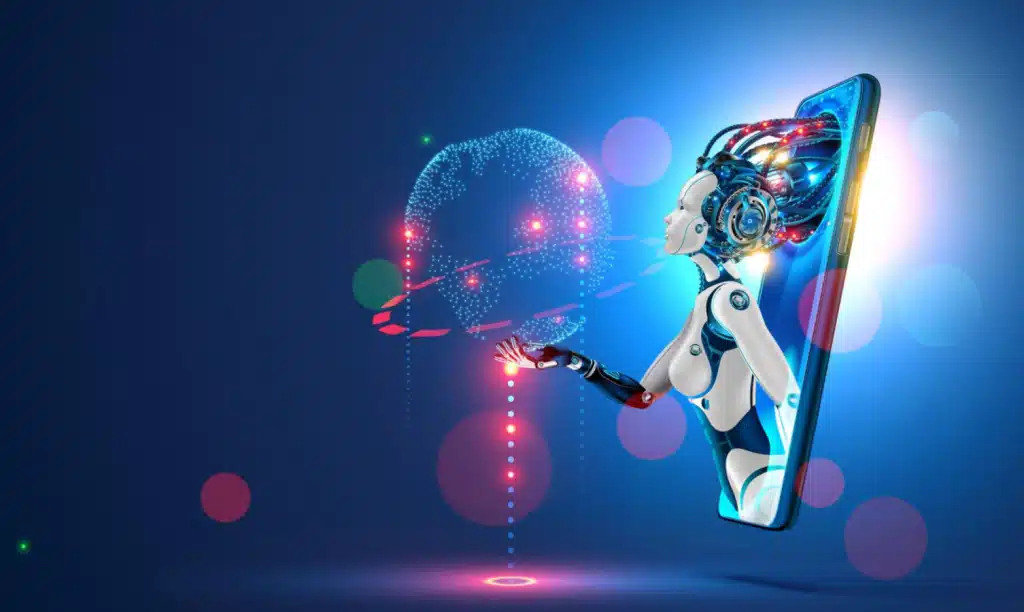From Zero to Launch: How Brands Are Using AI to Build in a Day
Subscribe to our newsletter
Keep up with the latest news in the digital marketing arena with Klik Digital. Subscribe Now!

For decades, bringing a new product or brand to market was an exercise in patience. It could take weeks just to finalize a name, months to build a prototype, and longer still to develop marketing materials and secure funding. The pace was dictated by human capacity, manual workflows, and the hard limits of creative and technical resources.
Today, those limits are dissolving. Artificial intelligence has upended the traditional timeline for product launches, compressing what once took months into days—and in many cases, into a single 24-hour sprint. The result is not simply faster launches; it’s an entirely new way of thinking about innovation, where speed is no longer a luxury but a core competitive advantage.
At Klik Digital, we’ve seen this shift firsthand. Startups, solo founders, and even large enterprise innovation teams are using AI tools to brainstorm, validate, design, build, and promote new products in less than a day. What’s driving this acceleration is not just automation—it’s the way AI augments human creativity, decision-making, and execution at every stage of the process.
Let’s walk through what a true zero-to-launch day looks like in the age of AI.
Step 1: AI Ideation That Actually Makes Sense
Every product begins with an idea, and traditionally, idea generation could take days of brainstorming sessions, sticky notes, and competitive research. Now, AI can collapse that entire process into hours—sometimes minutes—while still delivering thoughtful, relevant, and viable concepts.
Imagine you wake up with a loose concept: a platform to connect freelance chefs with event organizers. In the past, validating this would mean searching for comparable businesses, combing through market reports, and drafting positioning statements by hand. Today, you can feed your concept into advanced AI models like ChatGPT, Gemini, or Claude. These tools will not only refine your core idea but provide instant competitor analysis, audience segmentation, and even preliminary value propositions.
Some founders worry that such AI-powered ideation is “too generic” or “cookie-cutter,” but the real magic happens when you guide it with your unique insights. AI doesn’t replace your creative instincts—it accelerates them. In just one morning, you could move from a vague notion to a fully articulated business concept, complete with a target audience profile, market positioning, and potential revenue model.

Step 2: Naming, Branding, and Design—All in an Hour
Naming a brand is often the single biggest bottleneck in the early stages of a launch. Teams agonize over domain availability, trademark conflicts, and whether a name “sounds right.” AI naming platforms such as Namelix, Looka, and LogoAI make this process astonishingly quick. Feed them your concept and positioning, and they’ll generate dozens of viable, brand-worthy names in minutes, each with a matching logo concept and color palette.
Once a name is locked in, AI-driven design tools can produce a complete brand kit, mood boards, and even example marketing visuals. And while these outputs aren’t meant to replace professional designers for long-term brand development, they are perfect for getting to market quickly with a polished, cohesive look.
Voice and tone are equally important for a brand’s identity, and AI excels here as well. Natural language models can generate brand voice guidelines that match your positioning—whether you want to sound bold and disruptive, warm and approachable, or sleek and sophisticated. By midday, you’re not only clear on what your brand says, but exactly how it says it.
Step 3: MVP in a Day? Yes, Really!
The idea of building a minimum viable product in 24 hours used to sound absurd. Even no-code platforms required significant setup, trial and error, and manual configuration. But with AI-powered development assistants built into platforms like Replit, Bubble, and Webflow, the technical barrier to entry has dropped dramatically.
These tools allow even non-developers to design, prototype, and deploy functional products in record time. For example, you can describe the functionality you want—a booking system, payment integration, a dashboard—and AI will generate the underlying code, configure the database, and connect third-party APIs automatically. If you hit a snag, AI can debug and suggest improvements instantly.
For more complex needs, AI-driven automation platforms can integrate disparate tools into a seamless workflow. This means you can launch a serviceable version of your app or website before dinner, test it with early adopters, and gather feedback before most traditional projects have even finalized their wireframes.

Step 4: Marketing Materials on Autopilot
A launch without marketing is like a stage without an audience. In the past, preparing launch materials—landing pages, product explainers, social media campaigns—could take weeks. AI now compresses that timeline into hours without sacrificing quality.
AI-powered website builders can spin up optimized landing pages, complete with copy, images, and forms tailored to your audience. Copy generators like Copy.ai or Jasper create persuasive ad copy, while tools like Synthesia produce professional-grade product videos with AI-generated presenters, all without the need for cameras or crews.
Social media campaigns, too, can be ideated, written, and scheduled in a single afternoon. This means you can have your marketing engine ready to go before your product is even live, ensuring that as soon as you flip the switch, you’re speaking directly to the right audience with the right message.
Why This Isn’t Just a Trend—It’s a New Playbook
Speed-to-launch is more than a productivity hack; it fundamentally changes the innovation cycle. Shorter feedback loops mean you can validate or pivot faster, reducing the time and money wasted on unproven ideas. It also makes product development more inclusive, empowering non-technical founders and smaller teams to compete with much larger players.
There’s also a cost advantage. Traditional MVP development often required hiring specialized agencies or in-house developers, incurring significant expenses before a single customer interaction. AI reduces both the upfront cost and the risk, allowing you to experiment more freely and iterate more often.
Some worry that launching too quickly could compromise quality, but the key is to remember that an MVP is exactly that—minimum viable. The point isn’t to have a perfect product on day one; it’s to have a functional, testable version in the hands of real users so you can learn and adapt. AI simply makes that cycle happen at lightning speed.

The Smarter Way to Launch
If you’ve been holding back on a product idea because you think you lack the time, resources, or technical expertise, AI has removed those excuses. From ideation to design, development to marketing, the tools are now accessible, intuitive, and affordable enough to empower anyone with a strong concept and the willingness to execute.
At Klik Digital, we’re helping founders and teams reimagine what’s possible. We combine our expertise in digital strategy, brand development, and AI integration to ensure that your rapid launch isn’t just fast—it’s smart, strategic, and aligned with your long-term vision.
If you’re ready to see how quickly your next big idea can take shape, it’s time to explore what AI‑accelerated creativity can do for your business. Let’s build your tomorrow — starting today.
FAQs

It depends on your goal, but most teams combine:
- Ideation tools: ChatGPT, Gemini, Claude for concept validation.
- Branding tools: Namelix, Looka, LogoAI for instant identity creation.
- No-code builders: Bubble, Webflow, Framer for functional prototypes.
- Automation tools: Zapier AI, Make for backend processes.
- Marketing tools: Durable, Copy.ai, Synthesia for launch materials.
Yes. AI-enhanced no-code platforms and automation tools mean you don’t need to write a single line of code to produce a working MVP. In fact, some of the fastest 24-hour launches we’ve seen come from non-technical founders who excel at vision and storytelling.
Traditional MVPs often require a larger team, longer timelines, and custom coding. AI-built MVPs rely on pre-trained models, modular no-code platforms, and instant asset generation—cutting the time from months to hours while still delivering a functional, testable product.
Use AI to create a simple landing page or clickable prototype, then run low-cost ad campaigns or post in relevant online communities. Measure interest, signups, or pre-orders to decide whether to move forward.
Speed can magnify mistakes. AI-generated products can still have flaws in usability, security, or market fit. The key is to treat your 24-hour launch as a first iteration, not a final product—then refine based on real-world feedback.








